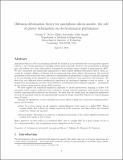| dc.contributor.author | Anand, Lallit | |
| dc.contributor.author | Di Leo, Claudio V | |
| dc.contributor.author | Rejovitzky, Elisha | |
| dc.date.accessioned | 2017-08-17T17:41:35Z | |
| dc.date.available | 2017-08-17T17:41:35Z | |
| dc.date.issued | 2015-04 | |
| dc.date.submitted | 2015-04 | |
| dc.identifier.issn | 0020-7683 | |
| dc.identifier.uri | http://hdl.handle.net/1721.1/110969 | |
| dc.description.abstract | Amorphous silicon (a-Si) is a promising material for anodes in Li-ion batteries due to its increased capacity relative to the current generation of graphite-based anode materials. However, the intercalation of lithium into a-Si induces very large elastic–plastic deformations, including volume changes of approximately 300%. We have formulated and numerically implemented a fully-coupled diffusion–deformation theory, which accounts for transient diffusion of lithium and accompanying large elastic–plastic deformations. The material parameters in the theory have been calibrated to experiments of galvanostatic cycling of a half-cell composed of an a-Si thin-film anode deposited on a quartz substrate, which have been reported in the literature. We show that our calibrated theory satisfactorily reproduces the mechanical response of such an anode — as measured by the changes in curvature of the substrate, as well as the electrochemical response — as measured by the voltage versus state-of-charge (SOC) response.
We have applied our numerical simulation capability to model galvanostatic charging of hollow a-Si nanotubes whose exterior walls have been oxidized to prevent outward expansion; such anodes have been recently experimentally-realized in the literature. We show that the results from our numerical simulations are in good agreement with the experimentally-measured voltage versus SOC behavior at various charging rates (C-rates).
Through our simulations, we have identified two major effects of plasticity on the electrochemical performance of a-Si anodes:
•
First, for a given voltage cut-off, plasticity enables lithiation of the anode to a higher SOC. This is because plastic flow reduces the stresses generated in the material, and thus reduces the potential required to lithiate the material.
•
Second, plastic deformation accounts for a significant percentage of the energy dissipated during the cycling of the anode at low C-rates.
Hence, plasticity can have either (a) a beneficial effect, that is, a higher SOC for a given voltage cut-off; or (b) a detrimental effect, that is significant energy dissipation at low C-rates. | en_US |
| dc.description.sponsorship | National Science Foundation (U.S.) Division of Civil, Mechanical and Manufacturing Innovation (Award CMMI-1063626) | en_US |
| dc.language.iso | en_US | |
| dc.publisher | Elsevier | en_US |
| dc.relation.isversionof | http://dx.doi.org/10.1016/j.ijsolstr.2015.04.028 | en_US |
| dc.rights | Creative Commons Attribution-NonCommercial-NoDerivs License | en_US |
| dc.rights.uri | http://creativecommons.org/licenses/by-nc-nd/4.0/ | en_US |
| dc.source | Prof. Anand via Angie Locknar | en_US |
| dc.title | Diffusion–deformation theory for amorphous silicon anodes: The role of plastic deformation on electrochemical performance | en_US |
| dc.type | Article | en_US |
| dc.identifier.citation | Di Leo, Claudio V. et al. “Diffusion–deformation Theory for Amorphous Silicon Anodes: The Role of Plastic Deformation on Electrochemical Performance.” International Journal of Solids and Structures 67–68 (August 2015): 283–296 © 2015 Elsevier Ltd | en_US |
| dc.contributor.department | Massachusetts Institute of Technology. Department of Chemical Engineering | en_US |
| dc.contributor.department | Massachusetts Institute of Technology. Department of Mechanical Engineering | en_US |
| dc.contributor.mitauthor | Anand, Lallit | |
| dc.contributor.mitauthor | Di Leo, Claudio V | |
| dc.contributor.mitauthor | Rejovitzky, Elisha | |
| dc.relation.journal | International Journal of Solids and Structures | en_US |
| dc.eprint.version | Author's final manuscript | en_US |
| dc.type.uri | http://purl.org/eprint/type/JournalArticle | en_US |
| eprint.status | http://purl.org/eprint/status/PeerReviewed | en_US |
| dspace.orderedauthors | Di Leo, Claudio V.; Rejovitzky, Elisha; Anand, Lallit | en_US |
| dspace.embargo.terms | N | en_US |
| dc.identifier.orcid | https://orcid.org/0000-0002-4581-7888 | |
| dc.identifier.orcid | https://orcid.org/0000-0002-1512-7173 | |
| mit.license | PUBLISHER_CC | en_US |
